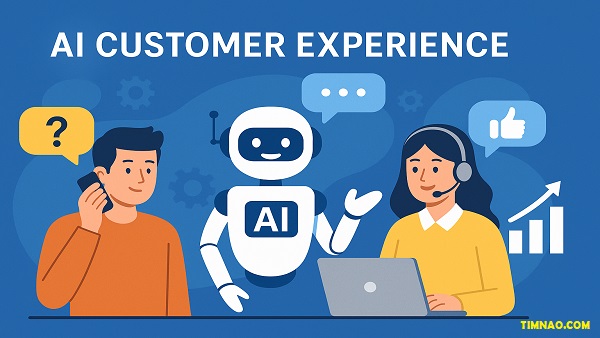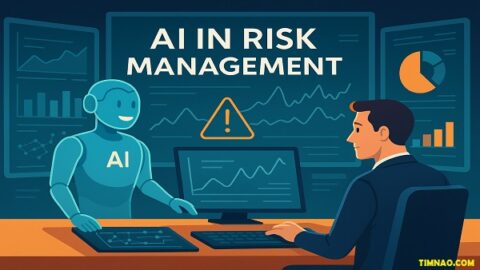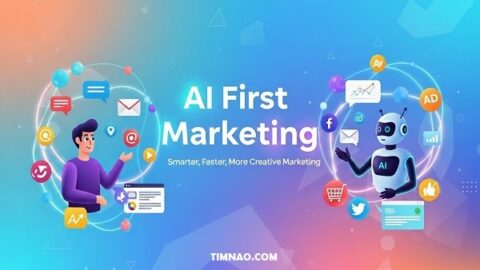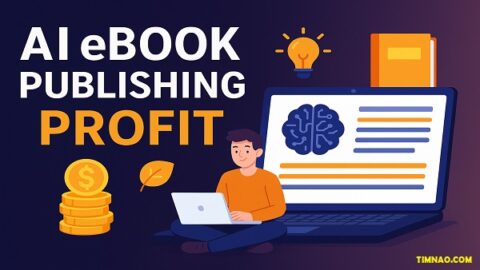Why AI Customer Experience Is a Game-Changer for Small Businesses 🚀 (And How to Get It Right)
AI customer experience has rapidly shifted from being a futuristic concept to a powerful necessity for businesses of all sizes—especially small and growing ones. In a world where customers expect lightning-fast replies, personalized interactions, and consistent service across every channel, traditional support methods just can’t keep up.
Whether you’re running a local café, an online store, or a creative freelance business, your ability to respond in real-time, understand customer needs, and create memorable interactions is what sets you apart. That’s where AI steps in—not to replace you, but to supercharge your customer service.
In this practical guide, we’ll show you exactly how to use AI to:
-
Respond faster without sacrificing quality
-
Personalize communication without sounding robotic
-
Track what’s working and improve it—using real data
-
Ethically deliver support that builds trust and long-term loyalty
And the best part? You don’t need coding skills, a tech team, or a huge budget.
Whether you’re brand new to AI or looking to upgrade your current approach, this beginner-friendly guide will walk you through everything step by step—with real tools, actionable tips, and powerful use cases from 2024–2025 that are working right now.
Now, let’s dive into how you can transform your business—one smart, AI-powered step at a time.
📚 Table of Contents
- 💡 Why AI Matters in Customer Experience Today
- 📍 Understanding the Modern Customer Journey
- 🤖 Core AI Tools You Can Use Right Now
- 🧠 Smart Personalization Without Losing the Human Touch
- ⚡ Speed Wins: Delivering Real-Time Support with AI
- 📏 Tracking What Works (and Fixing What Doesn’t)
- 🧪 Case Study: How a Local Café Used AI to Win Customers
- 🚫 Overcoming the Challenges and Doing AI Ethically
- 🔚 Final Thoughts: Small Steps, Big Results
- 📸 Bonus Tools & Action Plan You Can Start Today
- 🧩 FAQs: Questions Answered about AI Customer Experience
💡 Why AI Matters in Customer Experience Today
In today’s hyper-connected world, customer expectations have never been higher—or more difficult to meet. People now demand instant responses, personalized communication, and seamless support across every channel they use, from websites and mobile apps to social media and live chat.
For small businesses, meeting these expectations might sound like a tall order—especially with limited staff and budget. But here’s the good news: AI customer experience tools are no longer reserved for enterprise giants. They’re now accessible, affordable, and essential for any business that wants to grow.
The Shift: From Reactive Support to Smart Engagement
In the past, customer service was reactive. Customers had a problem, and businesses would respond—eventually. This model is now obsolete. Modern customer experience is proactive and data-driven, powered by AI systems that can:
- Respond to customers instantly, 24/7
- Understand user intent using natural language
- Recommend products or content based on past behavior
- Detect negative sentiment and escalate to human support
- Offer personalized experiences at scale
Why It Matters More Than Ever in 2025
Recent studies reveal the stakes:
- 79% of consumers now expect a brand to respond to inquiries within 15 minutes (Salesforce, 2025).
- 67% of buyers say they’ve switched to a competitor after a single poor customer experience (Zendesk, 2024).
- 80% of users are more likely to make a purchase from a brand that offers personalized experiences (McKinsey, 2025).
AI helps you meet these expectations—without hiring a huge support team.
The AI Advantage for Small Businesses
Even small teams can now deliver world-class service using AI. With the right tools, you can:
- Reduce support workload by automating FAQs and order inquiries
- Personalize communications in real-time with smart segmentation
- Respond faster with chatbots and self-service systems
- Build long-term loyalty by anticipating customer needs
Bottom line: AI customer experience levels the playing field. Whether you’re running a bakery, freelance agency, or SaaS startup, you can now offer support that rivals top-tier brands.
📍 Understanding the Modern Customer Journey
To deliver great service, you first need to understand how customers interact with your business across touchpoints. Today’s customer journey is anything but simple—it’s a dynamic, non-linear path with multiple twists, platforms, and channels.
Let’s break it down.
The 5 Stages of the Modern Customer Lifecycle
- 🧲 Discovery
Customers find you through social media, search engines, ads, or referrals. First impressions matter—this is where brand awareness begins. - 🚀 Onboarding
Whether they’re buying a product, signing up for a service, or downloading an app, the onboarding experience should be intuitive and frictionless. - 🛠️ Support
After the purchase, customers expect clear guidance, fast resolutions, and empathetic service—often in real time. - 🔁 Follow-Up
Great brands don’t stop after a sale. They follow up with personalized offers, check-ins, and satisfaction surveys to nurture the relationship. - 💎 Retention
Keeping customers engaged through loyalty programs, exclusive deals, and valuable content helps build lasting relationships—and boosts revenue.
Touchpoints That Define the Experience
Each of these stages contains micro-moments that can make or break the experience:
| Stage | Key Touchpoints |
|---|---|
| Discovery | Website, landing pages, Instagram, YouTube, search results |
| Onboarding | Signup forms, welcome emails, product walkthroughs |
| Support | Live chat, knowledge base, chatbot, phone or ticket system |
| Follow-Up | Post-purchase emails, review requests, re-engagement offers |
| Retention | Loyalty programs, seasonal campaigns, feedback requests |
The key is to connect these touchpoints seamlessly—and that’s where AI steps in.
How AI Optimizes the Journey
AI customer experience platforms help you:
- Identify friction points (e.g., abandoned carts or support delays)
- Personalize messages at every stage
- Predict when a customer is about to churn—and intervene
- Deliver consistent quality, even as your business scales
For example, AI can monitor behavior to see when someone stalls during checkout, then trigger a personalized chatbot to assist in real time. Or it can automatically follow up with customers after a support query to check satisfaction and recommend a related product.
Real-World Example: AI in Action
Case Snapshot: Homeware eCom Store (2025)
A small online store selling handcrafted kitchen tools mapped its customer journey using Google Analytics and Hotjar. They discovered users were dropping off during checkout due to delivery concerns.
✅ Solution:
- Deployed an AI chatbot to handle shipping queries in real-time
- Personalized follow-up emails based on cart content
- Used Zoho CRM to trigger re-engagement campaigns
Result?
- 22% increase in completed purchases
- 28% decrease in support tickets
- 2x higher retention rate for repeat buyers
Why Mapping the Journey Matters
Understanding your customer lifecycle allows you to:
- Prioritize improvements that actually move the needle
- Build predictable experiences across every channel
- Reduce response times and increase loyalty—using automation and AI
Remember: you can’t improve what you don’t measure. Start by mapping your journey, then use AI to enhance it where it matters most.
🤖 Core AI Tools You Can Use Right Now
You don’t need a tech team or a six-figure budget to bring AI into your customer experience. In 2025, some of the most powerful AI tools for improving customer service are affordable, easy to integrate, and designed for small teams.
Let’s explore the most impactful categories—and the best tools in each.
1. Chatbots and Virtual Assistants
These are your 24/7 support agents—powered by AI.
Whether it’s answering product questions, tracking orders, or scheduling appointments, modern chatbots are context-aware, meaning they can understand a customer’s intent and respond naturally.
✅ Best Tools:
- Tidio: Plug-and-play live chat + AI bot for small eCommerce
- Intercom: Popular among SaaS startups for smart, automated conversations
- Chatfuel: Great for integrating with Facebook and Instagram DMs
What’s New in 2025?
AI chatbots now use natural language processing (NLP) to hold multi-turn conversations that feel human. Many can even detect sentiment and escalate to a human if frustration is detected.
2. Self-Service Portals + AI Search
Customers increasingly prefer helping themselves. But generic FAQ pages don’t cut it anymore.
AI-enhanced help centers provide dynamic, searchable support experiences where answers are tailored to user behavior and past queries.
✅ Best Tools:
- Zendesk Guide: Uses AI to suggest the best answers automatically
- HelpCrunch: Combines self-service with human takeover for complex cases
Why It Matters:
Customers get faster answers. You reduce ticket volume. It’s a win-win.
3. Sentiment Analysis & Customer Feedback Intelligence
It’s not just what customers say—but how they feel when they say it.
AI tools now analyze the tone, emotion, and urgency behind reviews, social comments, and emails to surface hidden insights.
✅ Best Tools:
- MonkeyLearn: Turns unstructured feedback into visualized sentiment trends
- Brandwatch: Monitors brand mentions and mood across social platforms
- Chattermill: Enterprise-level insights, now with affordable small biz tiers
Pro Tip: Use these tools to catch dissatisfaction before it becomes a public complaint.
4. Predictive Analytics Engines
Want to know when a customer is likely to churn? Or what they’ll buy next? Predictive analytics uses AI to forecast future behavior based on past patterns.
✅ Best Tools:
- Zoho CRM: Predictive scoring built into affordable CRM
- Pecan AI: Forecasts churn, upsell, and lifetime value with zero-code models
- HubSpot AI: New AI Assistants predict trends across your pipeline
Real-World Win:
A 2024 case study by HubSpot found that predictive churn alerts reduced client loss by 31% for small service businesses using their free CRM.
5. Voice AI for Customer Support
Voice is back—and it’s smarter than ever. AI-powered voice systems now handle natural phone conversations with intelligent routing and empathetic responses.
✅ Best Tools:
- Talkdesk AI: Voice agents that resolve issues in minutes
- Five9 IVA: Enterprise-quality voice assistants, now available for SMBs
Bonus Insight:
Voice AI can now detect frustration levels, automatically switch to a human agent, and log emotional context in your CRM.
The Takeaway:
These tools aren’t just about automation—they’re about delivering a smarter, smoother, and more emotionally aware AI customer experience that meets modern expectations without overloading your team.
Start with one tool (like a chatbot or sentiment tracker), see the results, and expand from there.
🧠 Smart Personalization Without Losing the Human Touch
In 2025, personalization is the difference between a brand that just sells and one that builds loyalty.
The great news? AI makes personalization scalable—even for small businesses.
But there’s a catch: if it feels robotic, creepy, or irrelevant, it will backfire.
Let’s break down how to personalize the right way.
🎯 What Smart AI-Powered Personalization Looks Like
Modern AI customer experience platforms use real-time data to:
- Tailor product suggestions based on browsing behavior
- Adapt emails based on purchase history
- Recommend support content depending on user frustration signals
- Trigger offers before customers ask for help
This isn’t guesswork—it’s real-time prediction and adaptation.
🧩 Dynamic Content and Personalized Journeys
Tools like ActiveCampaign and Klaviyo now generate dynamic content blocks in emails or web pages.
Examples:
- A returning shopper sees a product they viewed last week at a discounted price
- A new user gets a welcome journey that adapts based on whether they clicked on the email or not
- An AI assistant suggests articles or upsells based on prior interactions
Result:
Higher engagement, longer retention, and more conversions with less effort.
🔍 AI-Driven Customer Segmentation
Forget static lists. AI can now segment your users dynamically based on:
- Purchase frequency
- On-site behavior (e.g., cart abandonment)
- Support history
- Product preferences and review sentiment
Tools like Drip or Ortto update these segments in real time and trigger automated flows tailored to each group.
🧠 Smart Offers, Sent at the Right Time
AI platforms now analyze the perfect moment to send:
- A promo code before a customer churns
- A reminder email just as the cart warms up
- A thank-you message when a loyalty threshold is hit
Tools like Rasa.io or Mailchimp AI handle this with minimal manual setup.
⚖️ Ethical Personalization: Do It Without Being Creepy
Personalization must never compromise trust. Here’s how to keep it ethical:
| Principle | Why It Matters |
|---|---|
| ✅ Consent-Based Data | Always ask for permission before tracking behavior or sending AI-driven offers. |
| ✅ Explain the Benefits | Tell users why you’re collecting data and what they’ll gain from it. |
| ✅ Offer Opt-Out Options | Let people control how personalized they want their experience to be. |
| ✅ Never Over-Personalize | Don’t overstep—AI shouldn’t guess intimate details or use sensitive info. |
Example:
A 2025 Shopify merchant saw a 40% lift in email open rates by allowing customers to choose what product categories they’d get personalized deals from.
Transparency builds trust—and trust builds loyalty.
💡 Personalization in Action: A Real 2025 Scenario
Business Type: Subscription box for eco-friendly home goods
Problem: Low repeat orders after 3 months
Solution:
- Used Klaviyo AI to identify top churn triggers
- Personalized onboarding with eco-tips matching product use
- Triggered “we miss you” offers based on engagement signals
Result:
- 2.5x higher retention after 60 days
- 18% increase in product upsells
- 95% of customers rated their experience “very personalized”
Final Word on Personalization:
AI doesn’t replace the human touch—it amplifies it.
Used well, it makes every customer feel like your business was built just for them. That’s the kind of experience that leads to loyalty—and lifelong brand love.
⚡ Speed Wins: Delivering Real-Time Support with AI
When it comes to customer experience, speed is no longer optional—it’s expected. In 2025, customers demand near-instant answers, whether they’re browsing your site at midnight or reaching out on social media during rush hour.
If your business can’t respond quickly, you risk losing trust, conversions, and repeat business.
Why Real-Time Support Matters (More Than Ever)
According to a 2025 report by SuperOffice:
- 88% of consumers expect a response within 60 minutes
- 62% expect instant support via chat
- Delayed replies are one of the top 3 reasons customers churn
Customers don’t just want help—they want it now. This is where AI customer experience platforms come in.
🚀 Key Benefits of Real-Time AI Support
- Reduced Response Times: AI-powered chatbots handle common queries instantly.
- Increased Customer Satisfaction: Fast support equals happier customers.
- Higher Conversion Rates: Quick answers at key decision points reduce cart abandonment.
- Lower Human Workload: AI handles repetitive tasks so your team can focus on complex cases.
⚙️ How to Implement Real-Time AI Support (Even as a Small Business)
1. Deploy AI Chatbots for Instant Help
Start with tools like:
- Tidio: For eCommerce stores
- ManyChat: For social media DMs
- Chatbot.com: Easy drag-and-drop builder
These bots can:
- Answer FAQs
- Recommend products
- Offer shipping updates
- Route complex queries to a human agent
✅ Pro Tip: Use AI to detect urgency or frustration (e.g., “where’s my order?!”) and auto-prioritize these cases.
2. Set Up Self-Service + Instant Knowledge Search
AI-enhanced help centers like Freshdesk or Zendesk Guide let users:
- Search for answers
- Watch tutorials
- Troubleshoot without contacting support
These systems adapt based on customer behavior—showing top articles, updating based on trends, and even personalizing suggestions.
3. Use Predictive AI to Act Before Problems Arise
Tools like Zoho CRM and Pega monitor behavior and:
- Alert your team when a customer is likely to churn
- Trigger proactive outreach (e.g., offer help before a customer complains)
- Optimize when and how to send support messages
This kind of anticipatory service builds serious brand loyalty.
📱 Real-World Success: Local Business, Global Impact
Business: A small Vietnamese skincare brand
Challenge: High support volume on Instagram
Solution:
- Added an AI chatbot (via ManyChat) to answer order questions in real-time
- Used predictive AI to spot repeat customers and offer faster service
Results (in 3 months):
- Response time dropped from 2 hours → under 2 minutes
- 23% boost in repeat purchases
- 40% fewer human support tickets
Lesson: Even small changes in support speed = massive gains in loyalty.
📏 Tracking What Works (and Fixing What Doesn’t)
Adding AI tools is only the beginning. If you want to grow and optimize your AI customer experience, you need to measure what’s working—and fix what isn’t.
That means tracking KPIs (Key Performance Indicators) in real time, analyzing what drives loyalty, and constantly improving the journey.
📊 The Metrics That Matter in 2025
| KPI | Why It Matters |
|---|---|
| ⏱️ First Response Time | Speed affects satisfaction. Track how fast you respond. |
| 🎯 Resolution Time | Faster issue resolution = higher loyalty. |
| 🤖 Bot-to-Human Ratio | Are your AI tools handling most tasks? If not, optimize. |
| 💬 CSAT (Customer Satisfaction) | Short feedback surveys help measure happiness. |
| 😤 Sentiment Scores | Use AI to monitor tone in messages, reviews, chats. |
| 🔁 Repeat Purchase Rate | A high repurchase rate means great experience. |
🧰 Tools to Help You Measure AI Customer Experience
💡 Customer Feedback + Sentiment
- Chattermill: Combines CSAT, reviews, and chat analysis
- MonkeyLearn: Tracks emotional tone across platforms
📈 Real-Time Support Dashboards
- Freshdesk Analytics: Visual dashboards + agent performance
- Power BI: Custom reports with CRM/AI data
- Google Looker Studio: Free, flexible visualization
📣 Voice of the Customer Platforms
- Medallia: Advanced journey mapping and feedback analytics
- Survicate: One-click NPS and post-chat surveys
🛠️ How to Turn Metrics Into Improvements
- Spot Trends
See if there’s a spike in complaints after a chatbot update or new product launch. - Refine Workflows
If response time is lagging, check where AI is getting stuck—and retrain it. - Improve Human-AI Handoffs
Make sure complex cases are escalated cleanly to human agents with full context. - Experiment and Iterate
A/B test support messages, timing of live chat triggers, or follow-up emails to improve metrics.
📚 Real-World Example: Data in Action
Business: Online language coaching platform
Pain Point: High drop-off during onboarding
Solution:
- Used Hotjar and ChurnZero to identify friction
- Switched onboarding messages to personalized AI assistant
- Added proactive chatbot for day 2–3 onboarding help
Results:
- Onboarding completion increased by 32%
- CSAT scores jumped from 4.1 → 4.7
- Monthly churn reduced by 18%
📌 Pro Tips to Improve Fast
- Set weekly review checkpoints for your support KPIs
- Let AI handle tracking—most platforms now offer built-in insights
- Don’t “set and forget” AI. Just like people, it needs coaching and review
- Use AI feedback loops to continuously learn from past interactions
The Bottom Line:
In 2025, great customer experience isn’t about doing more—it’s about doing smarter. AI helps you deliver real-time, personalized, scalable support. But it’s the metrics that help you refine, optimize, and grow.
Track what matters, improve what doesn’t, and you’ll turn every customer interaction into an engine of growth.
🧪 Case Study: How a Local Café Used AI to Win Customers
Let’s move from theory to real life.
Here’s how a small, independent café turned around its customer service and loyalty using simple AI tools—without hiring more staff or investing in expensive systems.
☕ The Problem
Bean & Bloom, a trendy café in Hanoi, Vietnam, was loved for its artisanal coffee—but struggling with:
- Long queues during peak hours
- Delayed responses to online inquiries (especially on Instagram)
- Missed opportunities for re-engagement after a first visit
Despite strong foot traffic, they were losing potential regulars due to inconsistent service and slow communication.
🤖 The AI-Driven Solution
In early 2024, the café’s owner decided to invest in affordable AI customer experience tools. Here’s what they did:
1. Deployed an AI Chatbot
Using Tidio, they launched a multilingual chatbot on their website and Instagram DMs to:
- Answer FAQs (opening hours, Wi-Fi password, menu)
- Let customers pre-order drinks
- Offer discount codes to new visitors
This freed up staff during peak hours while still delivering real-time answers.
2. Set Up Predictive Retargeting
They used Klaviyo to track behavior (e.g., first-time online orders) and sent automated emails with personalized offers like:
- “Your next latte is 20% off—just for you ☕”
- “Try our new coconut cold brew before Friday and get a free cookie 🍪”
3. Implemented Sentiment Analysis
Using MonkeyLearn, they analyzed customer reviews from Google, Foody, and social comments to identify common complaints—like wait times—and adjusted staffing accordingly.
📈 The Results (in Just 90 Days)
- 💬 Response time dropped from 2 hours → 3 minutes
- 🔁 Repeat customer rate increased by 38%
- 📉 Complaint mentions about “long wait” dropped by 41%
- 🧾 Email click-through rates improved by 22%
All of this with a team of five people, no developers, and tools that cost under $100/month combined.
🔑 Key Takeaways
- You don’t need to be a tech company to deliver fast, AI-powered service
- Small changes—like automating DMs—can dramatically improve loyalty
- Personalization + speed = real-world ROI, even for brick-and-mortar businesses
Moral of the story? The café didn’t just serve coffee. It served convenience, speed, and relevance—and that’s what today’s customers value most.
🚫 Overcoming the Challenges and Doing AI Ethically
While the benefits of AI in customer experience are enormous, it’s not all smooth sailing. AI done wrong can frustrate users, damage trust, and backfire hard—especially when it feels invasive or unhelpful.
Let’s break down the most common hurdles and how to overcome them the right way.
⚠️ Common Challenges Small Businesses Face
1. Over-Automation
When everything is handled by bots, the experience becomes cold and robotic. Customers get annoyed if:
- They can’t reach a human
- Their issue is too complex for the bot
- They feel like they’re talking to a wall
Solution: Use AI for speed, but always offer a clear “human help” option. Hybrid support wins.
2. Poorly Trained AI
Generic chatbots often give vague, unhelpful answers. If your bot says “I don’t understand” too often, users will abandon the conversation (and your brand).
Solution:
Invest time in training your AI with real FAQs, customer scenarios, and evolving feedback. Use tools with NLP (natural language processing) and regular updates.
3. Data Privacy Risks
Personalization requires data—but misusing it can lead to legal trouble or customer backlash.
2025 Watchpoints:
- Comply with laws like GDPR, CCPA, or Vietnam’s PDPD
- Don’t store sensitive info (credit cards, IDs) unless you’re 100% compliant
- Make your privacy policy clear and accessible
Solution: Be transparent. Let users opt in to personalization, and explain what data you use and why.
4. Lack of Strategy
AI is a tool—not a silver bullet. Many businesses jump in without a plan and end up overwhelmed or underwhelmed.
Solution: Start small. Choose one use case, test, learn, then expand.
Example: Begin with a chatbot → then add automated email follow-ups → then explore predictive analytics.
✅ 4 Golden Rules of Ethical AI Use
| Rule | Description |
|---|---|
| 🤝 Be Transparent | Let users know when they’re talking to AI—and how their data is used. |
| 🔐 Prioritize Privacy | Collect only what you need. Encrypt and protect customer data. |
| 📞 Maintain Human Access | Always give customers a way to reach a human for complex issues. |
| 📚 Keep Learning | AI needs ongoing training. Monitor performance and improve responses over time. |
🧠 Bonus Insight: Ethical AI = Competitive Edge
A 2025 global survey by PwC found:
“72% of consumers are more likely to trust brands that are transparent about their AI use—even if AI is used extensively.”
Ethical AI isn’t just a responsibility—it’s a brand advantage. When customers know your business values their privacy and comfort, they’re more likely to stick around.
Bottom Line:
Embracing AI is about enhancing the customer experience, not replacing the human element. With a thoughtful approach, even small businesses can harness the speed, power, and intelligence of AI—while staying authentic, human, and trustworthy.
🔚 Final Thoughts: Small Steps, Big Results
In 2025, the customer experience is no longer a “nice to have”—it’s your competitive edge.
But here’s the good news: you don’t need to be a tech wizard or Fortune 500 brand to deliver fast, personalized, and reliable support. With the right tools and mindset, even the smallest business can create a world-class AI customer experience.
Start small. Start smart. Focus on:
- Answering faster with AI chatbots
- Personalizing communication with smart segmentation
- Tracking what matters and improving one area at a time
- Being transparent and ethical with data
The results will compound: faster responses → happier customers → more loyalty → more revenue.
AI doesn’t replace the human element—it enhances it, giving you more time to focus on what really matters: building relationships and growing your brand.
📸 Bonus Tools & Action Plan You Can Start Today
Here’s your practical, beginner-friendly AI toolkit—no coding or IT team required.
🔧 Essential Tools for AI Customer Experience
| Tool | Category | Use Case |
|---|---|---|
| Tidio | Chatbot | Automate support & boost real-time replies |
| Klaviyo | Email + Segmentation | Smart personalization based on user behavior |
| MonkeyLearn | Sentiment Analysis | Understand what customers feel in messages & reviews |
| Zendesk Guide | AI Help Center | Build a self-service portal that gets smarter over time |
| Zoho CRM | Predictive AI | Spot at-risk customers and improve retention |
| Hotjar | Journey Mapping | Visualize how users interact with your site |
| Survicate | Feedback | Run CSAT/NPS surveys after AI or human support |
📝 Your 5-Step Action Plan
You don’t need to do everything at once. Follow this roadmap to get started:
- Audit Your Current Customer Experience
Identify the top 2–3 pain points—slow replies? High churn? Low feedback? - Pick One AI Tool That Solves a Problem
Start with a chatbot, email automation, or feedback analysis. - Set Clear Goals
Example: “Reduce response time to under 5 minutes” or “Improve repeat purchases by 15%”. - Monitor and Tweak Weekly
Use built-in analytics to track what’s working and what needs refining. - Scale What Works
As you gain confidence, add new tools or automate more touchpoints.
🧩 FAQs: Questions Answered About AI Customer Experience
Let’s clear up some common beginner questions around using AI in customer service.
🤖 Do I need to know coding or hire a developer to use these tools?
Not at all. Most modern AI tools are no-code or low-code, meaning anyone can use them with simple drag-and-drop interfaces or guided setup. Platforms like Tidio and Klaviyo are designed for small business owners, not tech pros.
⏱️ How fast can I see results?
Often within days. For example, deploying a chatbot can instantly cut response times and reduce support workload. Deeper improvements like retention or CSAT might take 30–60 days, depending on your goals.
💸 Is AI expensive?
It can be, but most tools offer free tiers or affordable plans starting at $10–$50/month. For example, MonkeyLearn has a free tier, and many CRMs like Zoho or Mailchimp include AI features in basic plans.
🔐 Is AI safe to use with customer data?
Yes—as long as you use tools that are GDPR/CCPA compliant and follow privacy best practices. Always be transparent about data use and avoid storing sensitive data without encryption.
🧠 Will AI replace my customer service team?
No. AI is meant to assist—not replace—your human team. It handles repetitive questions, freeing your staff to focus on complex issues, upselling, and building deeper relationships.
🌐 What if my customers prefer talking to a human?
That’s totally normal. The best AI customer experiences are hybrid—use AI to handle fast, simple tasks and always offer a “talk to a human” option for deeper support.
📉 What if my chatbot gives wrong answers?
This happens—but it can be fixed. Most platforms allow you to train your AI with better responses, FAQs, and fallback messages. Over time, your AI will learn and improve.
📊 How do I know if my AI efforts are working?
Track KPIs like:
- First response time
- Resolution time
- CSAT (Customer Satisfaction)
- Churn rate
- Repeat purchase rate
Use tools like Freshdesk Analytics or Power BI to monitor performance and make data-driven improvements.
🏁 Wrapping Up
By now, you’ve learned:
- Why AI customer experience is a must-have in 2025
- What tools to use—even on a budget
- How to personalize ethically and at scale
- How to track results and keep improving
- That AI is accessible, even for small businesses
You don’t need to build the future overnight—just start with one smart step today. Because the businesses that listen faster, personalize better, and support smarter will be the ones customers stick with for years to come.









